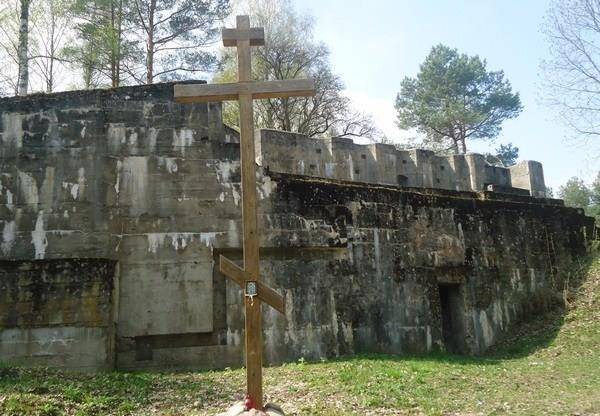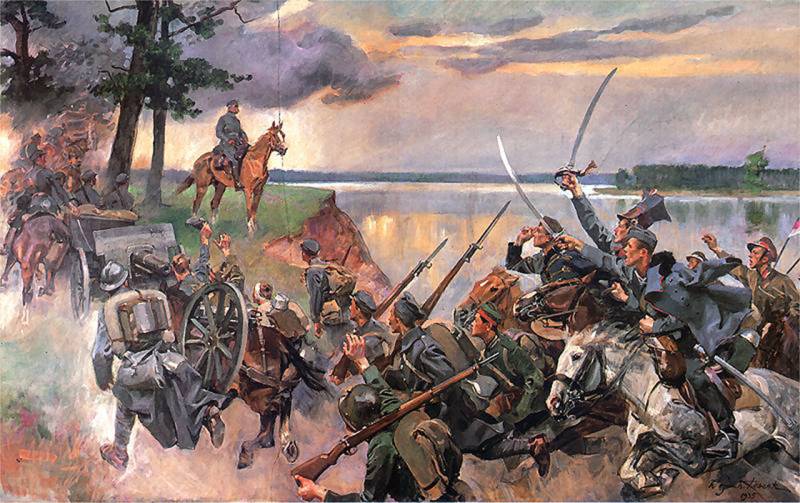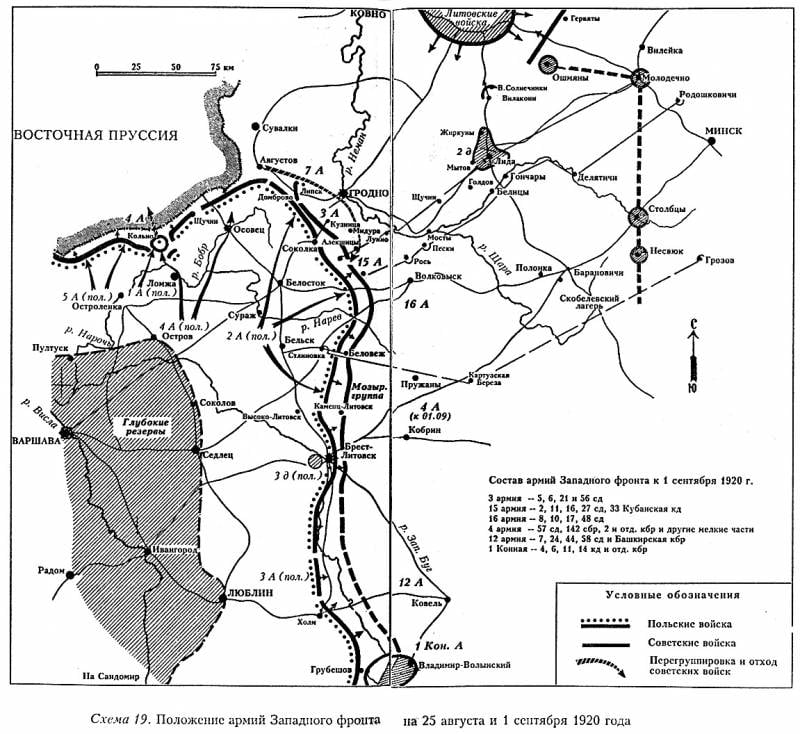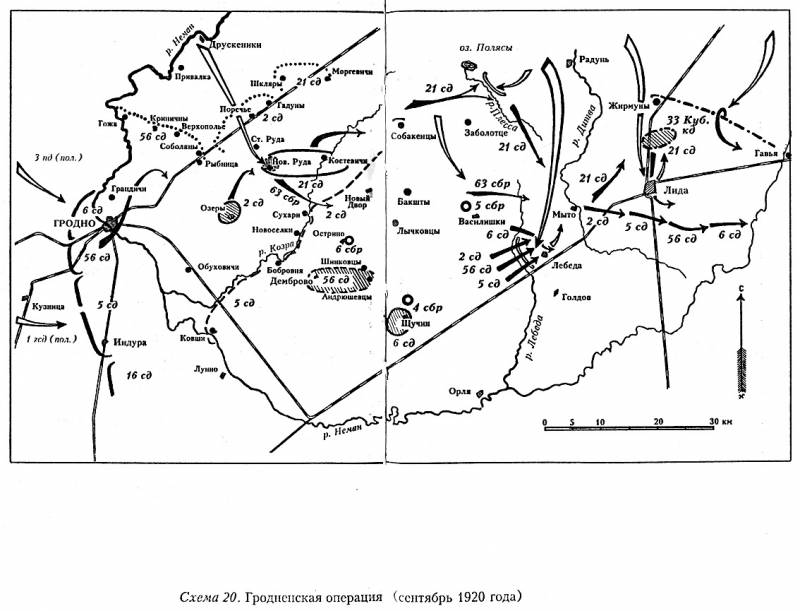Defeat of Tukhachevsky on the Neman
The Western Front lost the battle for Grodno and Volkovysk. This was mainly due to the mistakes of the command and poor intelligence. The enemy's strategic operation was overslept, since Tukhachevsky still dreamed of a "red Warsaw".
Battles on the Lithuanian border. Pruzhany
Before the start of the general offensive, the Polish army carried out several local operations, improving its position and moving forward slightly. In late August - early September 1920, there was a conflict between Poland and Lithuania. While moving to the east, Polish troops reached Augustów, where the Lithuanian border guards were stationed, who had moved into the area during the Red Army's offensive in July. The Poles demanded that the Lithuanians leave. They hesitated to answer, the Lithuanian authorities considered the southern part of Suvalkovshchyna theirs. Then the Poles disarmed the Lithuanian border guards, and on August 30 the 1st division of legionnaires occupied Augustów. Then the operational group of Colonel Nenevsky (4th cavalry brigade and 41st Suwalki infantry regiment) moved to Suwalki and Sejny. On September 1, Polish troops entered Suwalki.
The entry of Polish troops into the territory disputed with Lithuania raised the question of interaction between the Red Army and the Lithuanian. However, the Lithuanian government did not want to transfer its troops to the operational subordination of the Reds. On September 2, the 2nd Lithuanian division (7 thousand bayonets) launched an offensive on Suwalki and Augustow. Lithuanian troops occupied Lipsk, Sejny and went to Suwalki. However, the Polish cavalry went into the rear of the Lithuanian division, and the legionnaires launched an offensive from the front. Having lost only over 400 prisoners, the Lithuanians retreated. On September 7, Polish troops occupied Lipsk, on September 9 - Sejny and Krasnopol. On September 10, the Poles reached the Foch Line, a demarcation line between Poland and Lithuania, proposed by the Entente in 1919.
On September 18, 1920, the 14th Infantry Division of the Polish 4th Army received the task of taking Pruzhany, an important point on the way to Slonim. Having made a night march from the west from Shereshev, in the morning the Poles broke through the defenses of the Soviet 17th Infantry Division of the 16th Army near the city. When the main forces approached, the Polish battalions simultaneously attacked Pruzhany from the north, west and south. The Reds did not expect this attack, after a short battle the city fell. The 17th division retreated in disarray, losing only over 1 prisoners.
Battle in the region of Grodno and Berestovitsa
On September 20, 1920, the Central Group of the 2nd Army (22nd Volunteer and 21st Mountain Divisions) attacked the positions of the 5th and 6th Infantry Divisions of the 3rd Soviet Army. Not expecting a strong blow, the Soviet units rolled back to the fortifications of the Grodno fortress. Pulling up the army reserves, on September 21, the Red Army counterattacked, but without success. With the approach of Soviet reserves, the forces of the parties became approximately equal. Stubborn positional battles ensued. The same positions passed from hand to hand several times. The offensive of the 2nd Polish Army was stopped, but the main forces of the Western Front in the Grodno direction were shackled.
The 3rd Infantry Division of the Legions of General Berbetsky (about 8 thousand people, 40 guns, including 10 heavy ones, over 200 machine guns), which made up the right wing of the 2nd Army, also successfully advanced, pushing parts of the 11th and 16th divisions ( about 11 thousand people with 60 guns) of the 15th Soviet army. The Poles captured the undamaged bridges in Dublyany and Mostovlyany and crossed the Svisloch west of Berestovitsa. A stubborn battle broke out in the area of Berestovitsa. On September 21, the Poles broke into Bolshaya Berestovitsa, breaking through to the rear of the 11th Division. They defeated the divisional rear units and headquarters, captured about 300 people and captured 4 guns. Divisional Commander Sobeinikov was wounded, but was able to leave. Commander Kork sent the 56th brigade, which had just arrived from the Finnish border (3 thousand fighters), to a counterattack. On the 22nd, fierce battles continued all day, but the Red Army could not recapture Berestovitsa. The Soviet 33rd brigade and 16th division first pushed the enemy's 3rd division, but suffered heavy losses. Then the Poles counterattacked. With the support of neighboring units, by the evening the resistance of the 16th division was broken.
On September 23, the Poles captured Malaya Berestovitsa, but then the Reds again launched a counterattack. Only in the evening the 3rd division of legionnaires broke the enemy's resistance and reached the R. Vereteika, a tributary of the Svisloch. On September 24, the Cork army again counterattacked, but without success and suffered serious losses. In the evening, Polish troops resumed their offensive. The 15th Soviet Army began to withdraw, fearing encirclement due to the deteriorating situation in the north in the zone of defense of the 3rd Army. On September 25, the Poles advanced, almost without encountering serious resistance, and occupied Lunnu and the damaged bridge across the Neman. Thus, the Poles defeated the 15th Army: Soviet troops lost about 3 thousand people killed and captured. However, the Polish troops could not break through the enemy's defenses on the move, reach the bridges on the Neman and capture them. This was done only on the fifth day of the operation.
Breakthrough of the Northern group
The northern group of the 2nd Polish Army (1st Legionnaire Division, 1st Lithuanian-Belarusian Division, two cavalry brigades, a total of 15,5 thousand soldiers, 90 guns), concentrated in the Augustow region, received the task of rapidly advancing north east, bypass Grodno from the north, cross the Neman near the Lithuanian town of Druskeniki and within two days reach the town of Marcinkants (Marcinkonis) on the Grodno-Vilnia railway. The Poles intercepted communications of the Western Front going from Grodno to Mosty and Lida. The Soviet Grodno grouping was under the threat of encirclement.
On September 22, 1920, the Northern Group launched an offensive. Nenevsky's 4th cavalry brigade rushed forward and scattered the advanced units of the Lithuanian army. The 1st Legion Division struck at the 2nd Lithuanian Division near Seiny. Throwing back the enemy, the Poles captured Sejny and surrounded part of the Lithuanian troops. About 1700 people were captured, 12 guns were captured. On the night of the 23rd, the Poles defeated the Lithuanian regiment, capturing 300 people and 4 guns. On September 23, the Polish cavalry reached the bridge on the Neman near the town of Druskeniki. With the support of the approaching infantry, the Poles captured the bridge. On the 24th, the Poles occupied Marcinkants and reached Porechye (northeast of Grodno). As a result, the Polish army opened the road to Lida and received the opportunity to strike into the rear of Lazarevich's 3rd army. The command of the Western Front was so busy with battles in the Grodno and Berestovitsa region that they missed the enemy's breakthrough through Lithuanian territory and the Neman, with access to the rear of the 3rd Army. Tukhachevsky was preparing to repel the enemy's blow in the Grodno direction, and then launch a counteroffensive.
Fall of Grodno
The main forces of the 2nd Polish Army renewed their offensive against Grodno. On September 23, the Polish 21st Mountain Division fought for crossings south of Grodno, and the 22nd Volunteer Division fought to the north. On the night of September 23-24, Major Mond's group captured the damaged bridge on the Neman near Gozha. The Poles began to repair the bridge, part of the group's troops crossed the river on improvised watercraft. The headquarters of the 2nd Polish army ordered the 2nd cavalry brigade from the Northern group to go from the north to Grodno and connect with the Mond group.
In the meantime, the shock Northern group was marching in two columns towards Lida and Vasilishki. The Poles went to the rear of the Grodno grouping of the Red Army. The headquarters of the 3rd Soviet Army only on September 24 received the first data on the advancement of the Polish troops on the northern flank. The headquarters decided that the Poles were heading for Grodno. After negotiations with the front command, Lazarevich ordered to send the 2nd and 21st rifle divisions from the army reserve against this enemy group. This weakened the forces of the 3rd army in the Grodno direction.
The 5th Rifle Division, unable to withstand the pressure of the enemy, began to withdraw. With the support of heavy artillery, the 22nd Volunteer Division captured Fort No. 4 of the Grodno Fortress. Then the Reds themselves left forts No. 1, 2 and 3. In the northern sector, the Mond group captured Fort No. 13. By the evening of September 25, the Red Army lost its positions on the left bank of the Neman. The pressure of the Poles increased. The troops of the 3rd Army were threatened with encirclement from the north and northeast. In the south, the Poles broke through to Volkovysk. Tukhachevsky allowed Lazarevich to leave Grodno. On the night of September 26, Polish troops broke into the city. Soviet troops are retreating east. 3rd army retreats to Lida, 15th and 16th armies to r. Shchara.

Fort No. 4 of the Grodno Fortress
Volkovysk
On September 23, the northern group of General Jung (15th Infantry Division, part of the 2nd Legion Division) of the 4th Polish Army launched an offensive on Volkovysk. She struck at the junction of the 15th and 16th Soviet armies. The 48th Division of the 16th Army occupied the defense here. The Polish offensive here, too, caught the Soviet command by surprise. It was expected that the enemy would throw all its forces on Grodno through the Berestovitsa area. In a few hours, the regiments broke through the Red defenses and in the evening captured Volkovysk. The Soviet command transferred the 48th brigade from the Berestovitsa area to the aid of the 56th division. Also, the commander of the 15th Army, Cork, on September 24 threw the 27th Infantry Division into battle from the army reserve. During a fierce battle that lasted all day, the Red Army recaptured Volkovysk. The delay at Volkovysk, as well as at Mosty, delayed the advance of the Polish troops. This forced the Polish high command to reinforce the 2nd and 4th armies with front reserves.
Meanwhile, Tukhachevsky, fearing the encirclement of his armies, on the 25th ordered the troops to withdraw to the east. Before that evening on September 24, Tukhachevsky held negotiations with the chief of the Lithuanian General Staff, Kleshchinsky. The Soviet command offered the Lithuanians a joint offensive in the Suwalki-Grodno area. However, the Lithuanians again abandoned joint actions. As a result, the troops of the 3rd army were withdrawn to Lida, the 15th army to the rivers Lebeda and Shchara, the 16th to the r. Shchara. The territory had to be sacrificed in order to save the armies.
Thus, the Western Front lost the battle for Grodno and Volkovysk. This was mainly due to the mistakes of the command and poor intelligence. The enemy's strategic operation was overslept, since Tukhachevsky still dreamed of a "red Warsaw". The Poles pinned down the main forces of the Western Front in the Grodno area, struck a strong blow to the south, at Volkovysk, and bypassed the 3rd Soviet Army in the north across Lithuanian territory, aiming at Lida. This destroyed the Soviet front, Tukhachevsky's armies urgently had to retreat to the east again to avoid encirclement.



Information